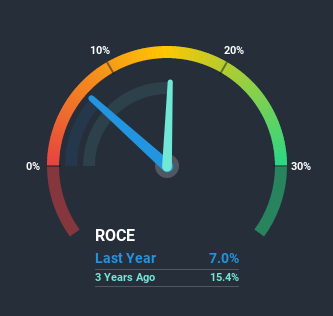
If you're looking at a mature business that's past the growth phase, what are some of the underlying trends that pop up? A business that's potentially in decline often shows two trends, a return on capital employed (ROCE) that's declining, and a base of capital employed that's also declining. This reveals that the company isn't compounding shareholder wealth because returns are falling and its net asset base is shrinking. So after we looked into Q & M Dental Group (Singapore) (SGX:QC7), the trends above didn't look too great.
What is Return On Capital Employed (ROCE)?
For those that aren't sure what ROCE is, it measures the amount of pre-tax profits a company can generate from the capital employed in its business. The formula for this calculation on Q & M Dental Group (Singapore) is:
Return on Capital Employed = Earnings Before Interest and Tax (EBIT) ÷ (Total Assets - Current Liabilities)
0.07 = S$12m ÷ (S$263m - S$85m) (Based on the trailing twelve months to June 2020).
So, Q & M Dental Group (Singapore) has an ROCE of 7.0%. In absolute terms, that's a low return and it also under-performs the Healthcare industry average of 8.8%.
Check out our latest analysis for Q & M Dental Group (Singapore)

Above you can see how the current ROCE for Q & M Dental Group (Singapore) compares to its prior returns on capital, but there's only so much you can tell from the past. If you'd like to see what analysts are forecasting going forward, you should check out our free report for Q & M Dental Group (Singapore).
What The Trend Of ROCE Can Tell Us
In terms of Q & M Dental Group (Singapore)'s historical ROCE movements, the trend doesn't inspire confidence. About five years ago, returns on capital were 10%, however they're now substantially lower than that as we saw above. On top of that, it's worth noting that the amount of capital employed within the business has remained relatively steady. This combination can be indicative of a mature business that still has areas to deploy capital, but the returns received aren't as high due potentially to new competition or smaller margins. If these trends continue, we wouldn't expect Q & M Dental Group (Singapore) to turn into a multi-bagger.
While on the subject, we noticed that the ratio of current liabilities to total assets has risen to 32%, which has impacted the ROCE. Without this increase, it's likely that ROCE would be even lower than 7.0%. Keep an eye on this ratio, because the business could encounter some new risks if this metric gets too high.What We Can Learn From Q & M Dental Group (Singapore)'s ROCE
In summary, it's unfortunate that Q & M Dental Group (Singapore) is generating lower returns from the same amount of capital. Long term shareholders who've owned the stock over the last five years have experienced a 24% depreciation in their investment, so it appears the market might not like these trends either. Unless there is a shift to a more positive trajectory in these metrics, we would look elsewhere.
If you want to know some of the risks facing Q & M Dental Group (Singapore) we've found 2 warning signs (1 is a bit concerning!) that you should be aware of before investing here.
While Q & M Dental Group (Singapore) isn't earning the highest return, check out this free list of companies that are earning high returns on equity with solid balance sheets.
If you’re looking to trade Q & M Dental Group (Singapore), open an account with the lowest-cost* platform trusted by professionals, Interactive Brokers. Their clients from over 200 countries and territories trade stocks, options, futures, forex, bonds and funds worldwide from a single integrated account. Promoted
Valuation is complex, but we're here to simplify it.
Discover if Q & M Dental Group (Singapore) might be undervalued or overvalued with our detailed analysis, featuring fair value estimates, potential risks, dividends, insider trades, and its financial condition.
Access Free AnalysisThis article by Simply Wall St is general in nature. It does not constitute a recommendation to buy or sell any stock, and does not take account of your objectives, or your financial situation. We aim to bring you long-term focused analysis driven by fundamental data. Note that our analysis may not factor in the latest price-sensitive company announcements or qualitative material. Simply Wall St has no position in any stocks mentioned.
*Interactive Brokers Rated Lowest Cost Broker by StockBrokers.com Annual Online Review 2020
Have feedback on this article? Concerned about the content? Get in touch with us directly. Alternatively, email editorial-team@simplywallst.com.
About SGX:QC7
Q & M Dental Group (Singapore)
An investment holding company, provides private dental healthcare services in Singapore, Malaysia, China, and internationally.
Very undervalued with proven track record.
Market Insights
Community Narratives




